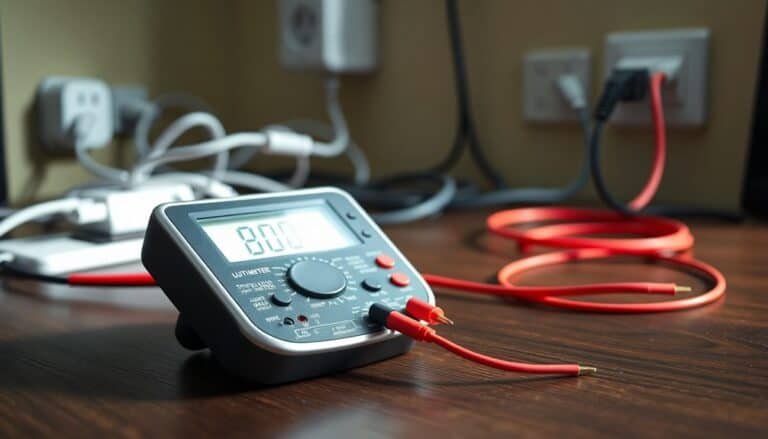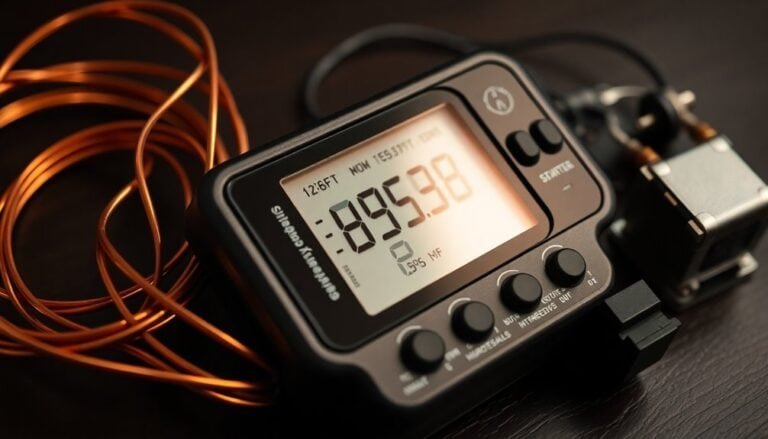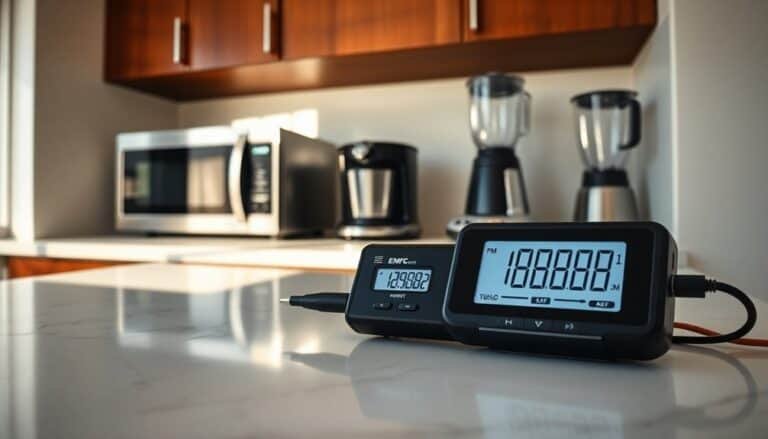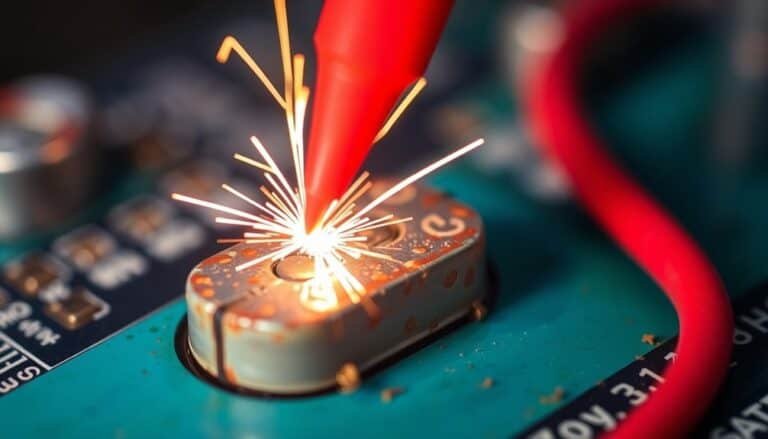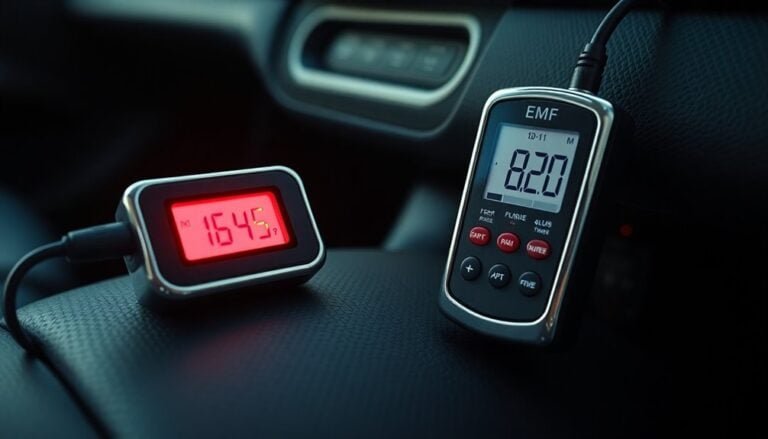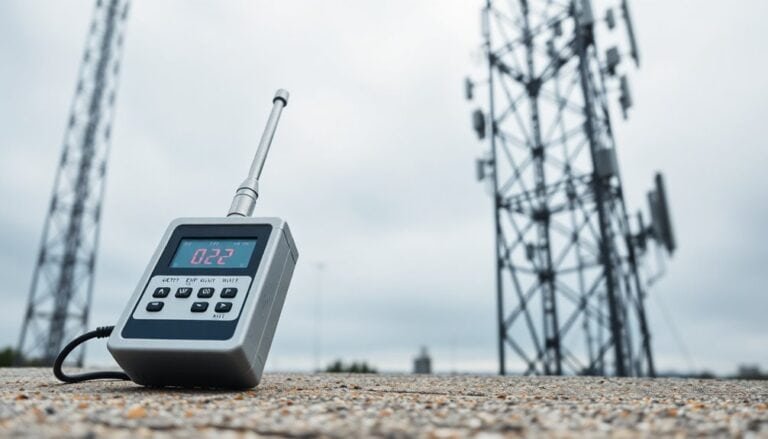How to Measure 5G Radiation Levels
To measure 5G radiation levels, use specialized RF EMF meters like the FM5 Meter for targeted frequencies or the SRM-3006 for measurements up to 29.5 GHz. Ensure devices meet ICNIRP safety standards for RF exposure.
Consider potential interference from existing technologies and the dynamic nature of massive MIMO to improve measurement accuracy. Understanding these factors is crucial for effective measurement techniques.
Disclaimer: As an affiliate, I may collect a share of sales from the links on this page.
Understanding 5G Radiation
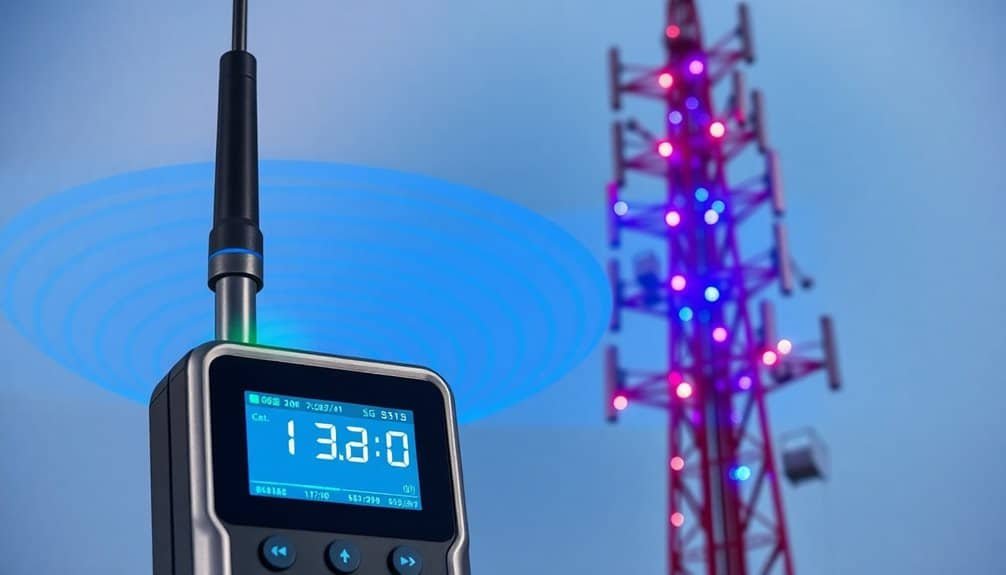
5G radiation primarily consists of radiofrequency electromagnetic fields (RF-EMF), which you encounter daily from mobile devices and base stations. Your exposure level varies based on your location and usage patterns, influenced by multiple beams from 5G antennas. Research hasn’t linked RF-EMF exposure from wireless technologies, including 5G, to adverse health effects. The main interaction in your body is tissue heating, with negligible temperature rises under current safety guidelines set by international organizations like the International Commission on Non-Ionizing Radiation Protection. Additionally, some studies have raised concerns about potential health risks associated with increased exposure to RF radiation, emphasizing the need for ongoing research. As EMF meters can measure certain frequencies of 5G radiation, they are vital tools for assessing exposure levels in various environments.
Tools for Measuring 5G Radiation
To effectively evaluate 5G radiation exposure, having the right measurement tools is essential.
Consider the FM5 Meter, which accurately measures radiofrequency radiation across targeted 5G frequencies.
The DEVIN Device conveniently attaches to your mobile phone, measuring cellular and Wi-Fi power with ± 1.5 dB accuracy.
The SRM-3006 offers frequency-selective measurements up to 29.5 GHz, perfect for detailed evaluations.
Apps like ElectroSmart and the Quanta Monitor provide RF measurements, though their 5G specificity isn’t guaranteed. Notably, the Safe and Sound Pro mmWave Meter is a high-quality option with a price range of $849.00 – $1,149.00 for comprehensive measurements.
Portability, data storage, and calibration are key features when choosing the right tool.
Evaluating the right options ensures effective monitoring of your environment.
Types of RF EMF Meters
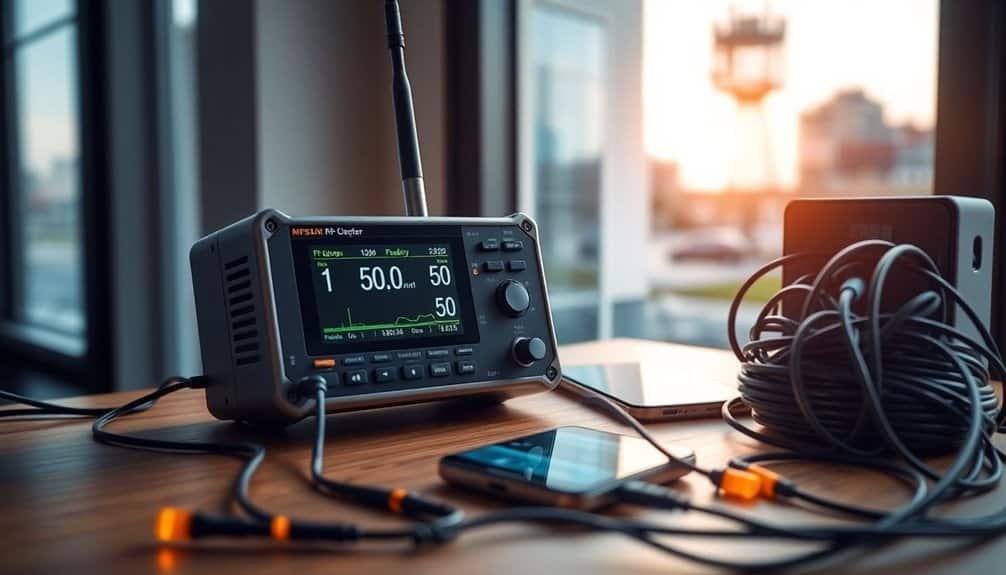
Understanding the different types of RF EMF meters is essential for accurately measuring radiation exposure. Various meters serve distinct purposes, helping you identify specific radiation levels in your environment.
- Power density meters measure the intensity of RF radiation. These devices are particularly useful for assessing 5G exposure due to their ability to detect lower frequency bands, making them effective for measuring emergency safety standards.
- All-in-one meters combine functionalities, capturing multiple field measurements simultaneously.
- Specialized RF meters focus primarily on detecting RF and microwave radiation.
Techniques for Accurate Measurement
Accurate measurement of 5G radiation levels relies on a variety of advanced techniques that enhance data reliability. The holographic technique combines unknown signals with stable references, ensuring precision.
Personal exposimeters, housed in backpacks, measure exposure using sensors in mobile devices. For 3D radiation patterns, the Active Antenna System (AAS) characterizes outputs thoroughly.
Dynamic Spectrum Sharing (DSS) demands specialized measurement approaches since it merges 4G and 5G signals. Spectrum analyzers, particularly the Narda SRM-3006, capture high-frequency signals in the 24-30 GHz range.
Environmental factors, such as weather and location, also influence exposure readings and need consideration in any analysis. Additionally, understanding safe distance recommendations is crucial for minimizing potential health risks associated with 5G exposure.
Safety Standards and Compliance
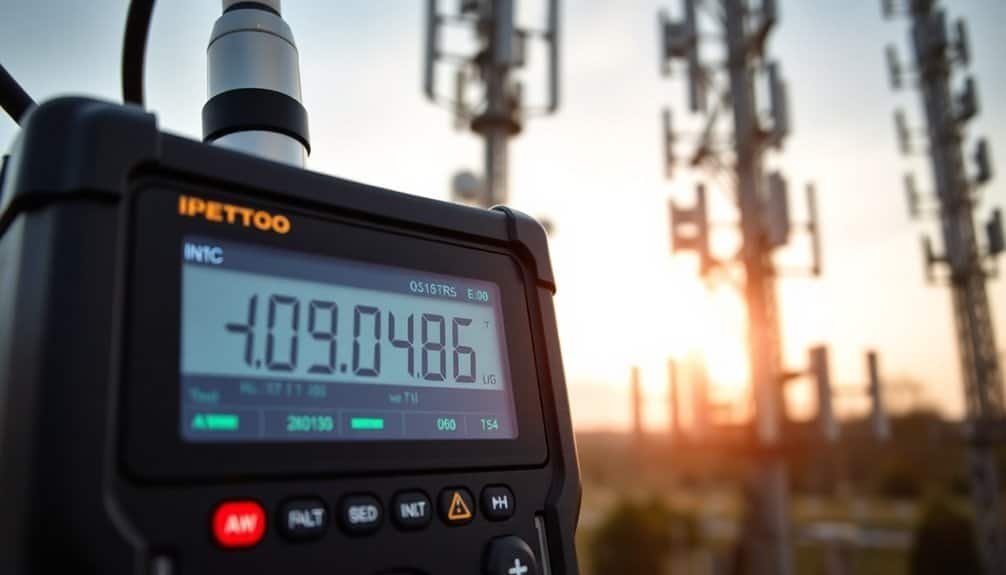
As 5G technology evolves, safety standards play an essential role in protecting public health. Organizations like ICNIRP provide guidelines for radiofrequency radiation (RFR) exposure, establishing limits to guarantee safety.
Adhering to these guidelines, particularly for frequencies above 6 GHz, helps manage potential risks.
- Specific Absorption Rate (SAR) measures how much radiation the body absorbs.
- Conservative calculations use maximum power levels for safety assessments.
- Updated guidelines consider new research, addressing public concerns related to health impacts.
Data Collection Methods
When measuring 5G radiation levels, various equipment and techniques play critical roles.
You’ll rely on RF meters, which measure frequencies from 50MHz to 6GHz, suitable for most 5G frequencies. Spectrum analyzers can assess higher ranges, like 24-30GHz. Exposimeters, often worn, track personal exposure to EMF.
For accuracy, use 3-axis antennas, essential due to beamforming technology. Continuous monitoring offers real-time data, while code selective measurement isolates specific signals.
Consider environmental factors like distance, obstacles, and weather conditions; they’ll impact your results.
In all, a systematic approach guarantees accurate and meaningful measurements.
Analyzing Measured Data
Analyzing measured data from 5G radiation levels involves a systematic approach to guarantee accurate interpretation.
You’ll assess various factors, including exposure scenarios and specific technologies.
Focus on:
- RF-EMF Levels: Evaluate radiation levels from base stations and devices in different environments.
- Beamforming Effects: Investigate how this technology alters exposure near users.
- Scenario-Based Analysis: Analyze data based on usage, such as during data-heavy activities.
Challenges in Measuring 5G Radiation
Measuring 5G radiation presents several challenges that can complicate accurate assessments. The use of massive MIMO technology introduces dynamic beam steering, affecting RF EMF exposure evaluations. Additionally, varied radiation patterns complicate the exposure level determination.
Limited access to detailed 5G infrastructure data hinders effective measurement planning. Specialized, often costly equipment is required to measure high-frequency bands, adding further complexity. Interference from existing wireless technologies and the requirement for regular calibration complicate accuracy.
Furthermore, understanding measurement results necessitates user education, ensuring compliance with regulatory standards like ICNIRP is essential for valid assessments. These factors collectively challenge reliable measurement of 5G radiation.
Community Engagement and Transparency
Community engagement and transparency are essential components in addressing public concerns about 5G radiation. You need to understand that open communication fosters trust within the community, mitigates fears, and promotes informed discussions.
Key strategies include:
- Effective risk communication to address misperceptions regarding 5G radiation.
- Public engagement channels for ongoing updates about safety guidelines and research.
- Collaboration with stakeholders, including health agencies and community groups, to establish evidence-based safety measures.
These steps not only reassure you about the safety of 5G technology but also guarantee community values shape health policies effectively.
Future of 5G Radiation Measurement
The future of 5G radiation measurement involves significant advances in technology and methodology that aim to address public concerns effectively.
Compact, portable devices will provide accessible assessments. Near-field techniques will enhance detection accuracy in congested environments. Real-time antenna measurements will adapt to dynamic beamforming.
Automation through machine learning will analyze complex data trends. Network management system integration will facilitate exposure prediction.
Innovative beam tracking methods and spatio-temporal measurements will tackle fluctuating intensities. Standardization bodies will refine guidelines for reliable results, while user-centric protocols will capture realistic exposure scenarios.
Continuous research guarantees safety standards evolve, aligning with real-world 5G radiation challenges.
Frequently Asked Questions
How Does Weather Affect 5G Radiation Measurements?
Weather notably affects 5G radiation measurements by causing signal attenuation, reflection, and scattering. When conditions worsen, you’ll need to adjust your methods and data to accurately capture the true signal strengths impacted by the elements.
Are There Any Health Symptoms Linked to 5G Exposure?
You might worry about health symptoms linked to 5G exposure, but current research shows insufficient evidence directly connecting 5G to adverse effects. Most studies find no significant health risks from low RF exposure levels.
Can I Measure 5G Radiation at Home?
Did you know that RF-EMF exposure may rise by 50% in densely populated areas? You can measure 5G radiation at home with specialized meters. Educating yourself on EMF can help you minimize exposure effectively.
What Materials Block or Reduce 5G Radiation?
To block or reduce 5G radiation, you can use materials like copper, aluminum, and silver-infused fabrics. Each offers different shielding effectiveness, so choose based on your specific needs and installation preferences for best results.
How Often Should I Measure 5G Radiation Levels?
You should measure 5G radiation levels frequently, especially in high-density areas or after infrastructure changes. Staying updated on regulations and environmental factors guarantees compliance and public safety while effectively addressing any community concerns.
Conclusion
To understand 5G radiation, use RF EMF meters to measure it accurately. Mastering these techniques ensures safety compliance, similar to a sailor following navigational charts. Analyzing data helps navigate future challenges, while staying informed guides you through the evolving 5G landscape.

